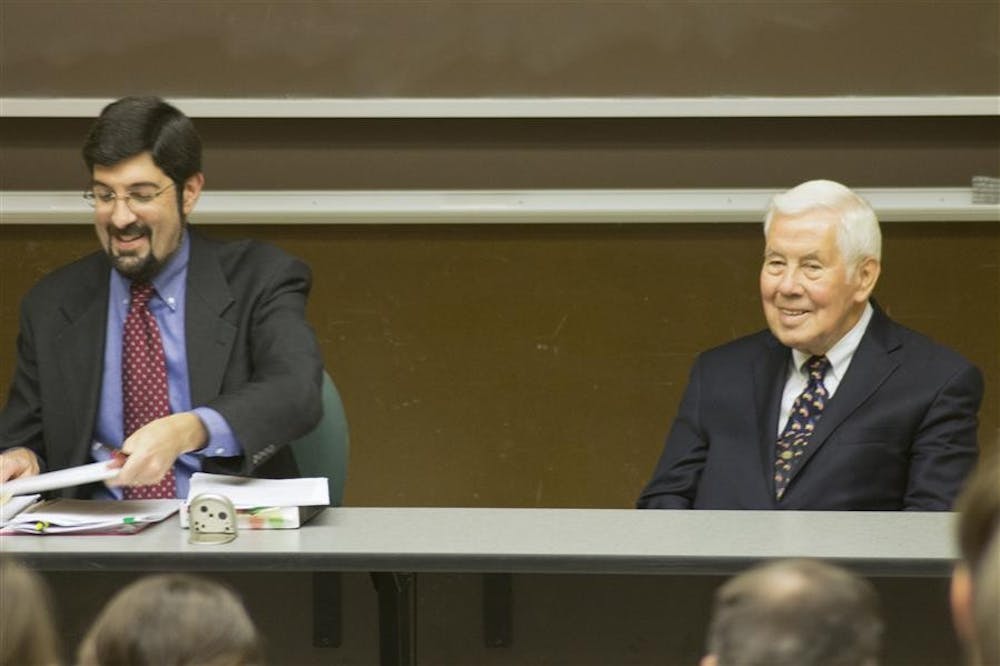Richard Lugar, former U.S. Senator for Indiana and Stephen Schwartz, editor of the James Martin Center for Nonproliferation Studies journal, discussed the unknown history of the nuclear triad in Ballantine Hall on Friday evening.
The discussion was organized by the Center on American and Global
Security.
Schwartz’s talk was entitled “The Tale of the Triad: The Unknown History and Uncertain Future of America’s Nuclear Arsenal,” with commentary by Lugar.
The nuclear triad refers to the nuclear arsenal, consisting of strategic bombers, intercontinental ballistic missiles and submarine-launched ballistic missiles.
The term was applied to United States’ long range or strategic nuclear weapons that would be used to attack adversaries in their homeland, Schwartz said.
“We are at a very interesting time I would argue and a critical moment in U.S. arsenal,” Schwartz said.
The ongoing work to reduce U.S. nuclear weapons, modernize and update them and budget frustrations are all factors to this critical moment, Schwartz said.
Schwartz noted that while thinking more about the title of his talk, it would be more accurate to call it the ignored history of the U.S. nuclear arsenal, instead of forgotten or unknown.
There are different theories of how the triad came about.
One story goes that there was an analyst in the department of defense around the 1960s who came up with the concept, Schwartz said.
Schwartz said whatever the origin of the triad is, it is critical to understand the triad was not the product of logical analyses, and no one planned on building it.
“It’s an accidental artifact of the cold war,” Schwartz said.
The triad is a product of competition spurred by a number of forces, Schwartz said.
The competition was between the United States and the Soviet Union, but also between each military service such as the Air Force, Navy and Army, due to budgetary questions, Schwartz said.
If a nation wanted to be a player in the nuclear age, it had to have nuclear weapons programs, Schwartz said.
The amount of weapons pumped out at that time was driven by the rivalry of the competing services, Schwartz said.
All the nuclear weapons derived from that time may also have been because they were supposedly going to be less expensive and considered a bigger bang for a buck, Schwartz said.
They were seen as a way to safeguard the U.S. while not bankrupting it.
In the end, nuclear weapons were actually more expensive due to the fact that they required tremendous amounts of extra security, were very labor intensive, required many specialists and created a need for reserve forces.
“If you’re going to fight a nuclear war anywhere else and your adversary has nuclear weapons, your front lines will be wiped out, and you have to have a reserve force ready to go,” Schwartz said.
Schwartz also discussed some benefits of the triad. For one, ballistic missiles were prompt and on constant alert, and it is possible to launch all the missiles simultaneously if desired.
One of the arguments that is made for the nuclear triad is to compare it to a type of insurance policy for the U.S., Schwartz said. However, he said it would be a very peculiar insurance because it increases odds of the U.S. needing insurance.
“Would you purchase a health care plan if getting the insurance increased your odds of getting sick or dying?” Schwartz said.
It is important to know the history of the nuclear triad because the United States was spending money on things that were not necessary, Schwartz said.
“Creating rational and cost effective policy for the future requires us to understand the past,” Schwartz said.
After Schwartz’s talk, Lugar shared his commentary.
For 40 years, the U.S. used the term mutually insured destruction, Lugar said.
Lugar said it meant the United States believed that the United States and the Soviet Union had the ability to destroy every military installation, urban area and the entire population of both countries.
Lugar said in 1989, the U.S. had a stock pile of 22,217 nuclear weapons and was spending $6.1 billion for the programs. Twenty years later, in 2009, the stock pile was reduced by 77 percent to 5,133 weapons, but the budget for the program was
increasing.
Follow reporter Mary Hauber on Twitter @mary_hauber.
Schwartz, Lugar discuss nuclear weapons Friday

Get stories like this in your inbox
Subscribe





